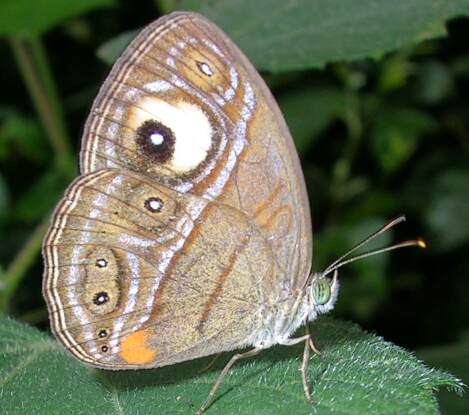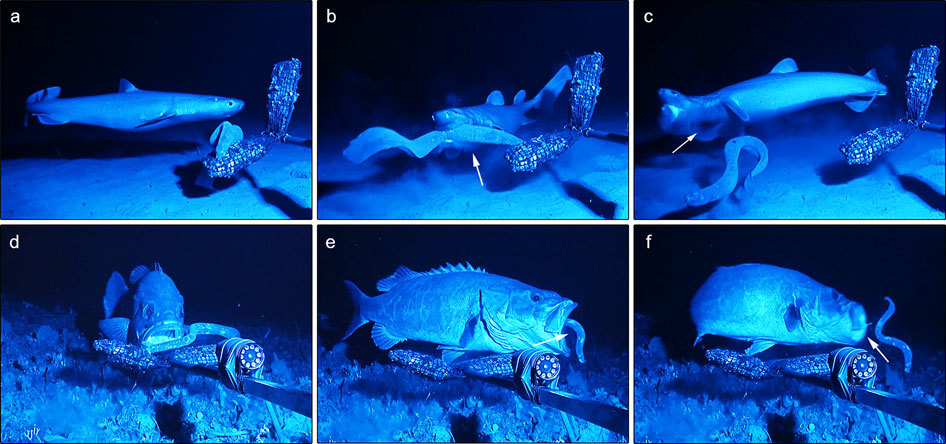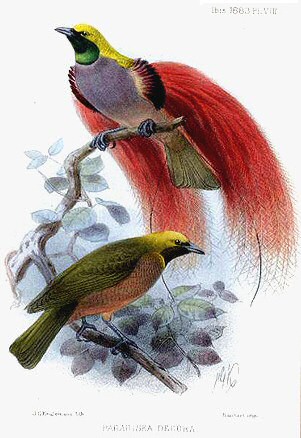|
Eyespot (mimicry)
An eyespot (sometimes ocellus) is an eye-like marking. They are found in butterflies, reptiles, cats, birds and fish. Eyespots could be explained in at least three different ways. They may be a form of mimicry in which a spot on the body of an animal resembles an eye of a different animal, to deceive potential predator or prey species. They may be a form of self-mimicry, to draw a predator's attention away from the prey's most vulnerable body parts. Or they may serve to make the prey appear inedible or dangerous. Eyespot markings may play a role in intraspecies communication or courtship; the best-known example is probably the eyespots on a peacock's display feathers. The pattern-forming biological process (morphogenesis) of eyespots in a wide variety of animals is controlled by a small number of genes active in embryonic development, including the genes called Engrailed, Distal-less, Hedgehog, Antennapedia, and the Notch signaling pathway. Artificial eyespots have been show ... [...More Info...] [...Related Items...] OR: [Wikipedia] [Google] [Baidu] |
Mycalesis Patnia
''Mycalesis patnia'', the glad-eye bushbrown, is a Satyrinae, satyrid butterfly found in southern India and Sri Lanka. Description Upperside: The male has a dark umber-brown ground colour slightly suffused with ochraceous. Forewings and hindwings with bright ochraceous-yellow, slender sub-terminal and terminal lines; cilia pale brown. Forewing with a large median and a much smaller subapical white-centred black ocellus, each with an orange-yellow iris, the upper portion of the iris round the median ocellus very broad, the lower incomplete and a more or less triangular orange-yellow discal patch. Hindwing uniform, with two very small fulvous-ringed black eyespot (mimicry), ocelli. Underside of male deep ochraceous yellow, subterminal and terminal line as on the upperside; forewing and hindwing crossed near base by a darker ochraceous-yellow line, followed by a silvery discal band, beyond which there are two ocelli as on the upperside, but each encircled also by an outer silvery ... [...More Info...] [...Related Items...] OR: [Wikipedia] [Google] [Baidu] |
Antipredator Adaptation
Anti-predator adaptations are mechanisms developed through evolution that assist prey organisms in their constant struggle against predators. Throughout the animal kingdom, adaptations have evolved for every stage of this struggle, namely by avoiding detection, warding off attack, fighting back, or escaping when caught. The first line of defence consists in avoiding detection, through mechanisms such as camouflage, masquerade, apostatic selection, living underground, or nocturnality. Alternatively, prey animals may ward off attack, whether by advertising the presence of strong defences in aposematism, by mimicking animals which do possess such defences, by startling the attacker, by signalling to the predator that pursuit is not worthwhile, by distraction, by using defensive structures such as spines, and by living in a group. Members of groups are at reduced risk of predation, despite the increased conspicuousness of a group, through improved vigilance, predator confus ... [...More Info...] [...Related Items...] OR: [Wikipedia] [Google] [Baidu] |
Geoffroy's Cat
Geoffroy's cat (''Leopardus geoffroyi'') is a small wild cat native to the southern and central regions of South America. It is about the size of a domestic cat. It is listed as Least Concern on the IUCN Red List because it is widespread and abundant over most of its range. Taxonomy Geoffroy's cat is named after the 19th century French zoologist Étienne Geoffroy Saint-Hilaire (1772–1844). It was identified as ''Felis geoffroyi'' in 1844 by French naturalists Alcide d'Orbigny and P. Gervais on the basis of three specimens that d'Orbigny had collected on the banks of the Rio Negro in Patagonia during his travels in South America between 1826 and 1833. Five subspecies have been described based on geographic dispersement: *''L. g. geoffroyi'': Central Argentina *''L. g. euxantha'': Northern Argentina, Western Bolivia *''L. g. leucobapta'': Patagonia *''L. g. paraguae'': Paraguay, Southeastern Brazil, Uruguay, Northern Argentina *''L. g. salinarum'': Northwestern and Cen ... [...More Info...] [...Related Items...] OR: [Wikipedia] [Google] [Baidu] |
Felidae
Felidae () is the family of mammals in the order Carnivora colloquially referred to as cats, and constitutes a clade. A member of this family is also called a felid (). The term "cat" refers both to felids in general and specifically to the domestic cat ('' Felis catus''). Felidae species exhibit the most diverse fur pattern of all terrestrial carnivores. Cats have retractile claws, slender muscular bodies and strong flexible forelimbs. Their teeth and facial muscles allow for a powerful bite. They are all obligate carnivores, and most are solitary predators ambushing or stalking their prey. Wild cats occur in Africa, Europe, Asia and the Americas. Some wild cat species are adapted to forest habitats, some to arid environments, and a few also to wetlands and mountainous terrain. Their activity patterns range from nocturnal and crepuscular to diurnal, depending on their preferred prey species. Reginald Innes Pocock divided the extant Felidae into three subfamilies: th ... [...More Info...] [...Related Items...] OR: [Wikipedia] [Google] [Baidu] |
Sand Lizard
The sand lizard (''Lacerta agilis'') is a lacertid lizard distributed across most of Europe from France and across the continent to Lake Baikal in Russia. It does not occur in European Turkey. Its distribution is often patchy. In the sand lizard's northern populations, such as in Great Britain, it is only able to survive along coastal heathlands where the sand is hot enough to incubate their eggs. Males are known for their bright colorations and aggressive behaviors when competing for females. Their mating process is unique because of its relatively short time period and because males are generally more selective with who they mate with than females. Females typically only lay a single clutch in a year. Sand lizards spend most of their time basking, foraging, or under vegetation and prefer to live in diverse habitats. Males have their own home territories that are very wide and often overlap with other males. These males compete with each other while females have smaller home ter ... [...More Info...] [...Related Items...] OR: [Wikipedia] [Google] [Baidu] |
Theclinae
The subfamily Theclinae is a group of butterflies, often referred to as hairstreaks, with some species instead known as elfins or by other names. The group is part of the family Lycaenidae, the "gossamer-winged butterflies". There are many tropical species as well as a number found in the Americas. Tropical hairstreaks often have iridescent blue coloration above, caused by reflected light from the structure of the wing scales rather than by pigment. Hairstreaks from North America are commonly brown above. Few Theclinae are migratory. Members of this group are described as 'thecline'. Systematics The systematics and phylogeny of the numerous Theclinae has not reached a robust consensus yet. The arrangement presented here is based on Savela (2007), but be aware that it is probably oversplit and several tribes may not be valid. Nonetheless, the tribes as listed here generally seem to represent monophyletic lineages, but whether this is indeed so and whether these are distinct eno ... [...More Info...] [...Related Items...] OR: [Wikipedia] [Google] [Baidu] |
Salticidae
Jumping spiders are a group of spiders that constitute the family Salticidae. As of 2019, this family contained over 600 described genera and over 6,000 described species, making it the largest family of spiders at 13% of all species. Jumping spiders have some of the best vision among arthropods and use it in courtship, hunting, and navigation. Although they normally move unobtrusively and fairly slowly, most species are capable of very agile jumps, notably when hunting, but sometimes in response to sudden threats or crossing long gaps. Both their book lungs and tracheal system are well-developed, and they use both systems (bimodal breathing). Jumping spiders are generally recognized by their eye pattern. All jumping spiders have four pairs of eyes, with the anterior median pair being particularly large. Distinguishing characteristics Jumping spiders are among the easiest to distinguish from similar spider families because of the shape of the cephalothorax and their eye patt ... [...More Info...] [...Related Items...] OR: [Wikipedia] [Google] [Baidu] |
Lycaenidae
Lycaenidae is the second-largest family of butterflies (behind Nymphalidae, brush-footed butterflies), with over 6,000 species worldwide, whose members are also called gossamer-winged butterflies. They constitute about 30% of the known butterfly species. The family comprises seven subfamilies, including the blues ( Polyommatinae), the coppers ( Lycaeninae), the hairstreaks ( Theclinae), and the harvesters ( Miletinae). Description, food, and life cycle Adults are small, under 5 cm usually, and brightly coloured, sometimes with a metallic gloss. Larvae are often flattened rather than cylindrical, with glands that may produce secretions that attract and subdue ants. Their cuticles tend to be thickened. Some larvae are capable of producing vibrations and low sounds that are transmitted through the substrates they inhabit. They use these sounds to communicate with ants.Pierce, N. E.; Braby, M. F.; Heath, A.; Lohman, D. J.; Mathew, J.; Rand, D. B. & Travassos, M. A. (2002)"The ... [...More Info...] [...Related Items...] OR: [Wikipedia] [Google] [Baidu] |
Sphingidae
The Sphingidae are a family of moths ( Lepidoptera) called sphinx moths, also colloquially known as hawk moths, with many of their caterpillars known as “hornworms”; it includes about 1,450 species. It is best represented in the tropics, but species are found in every region.Scoble, Malcolm J. (1995): ''The Lepidoptera: Form, Function and Diversity'' (2nd edition). Oxford University Press & Natural History Museum London. They are moderate to large in size and are distinguished among moths for their agile and sustained flying ability, similar enough to that of hummingbirds as to be reliably mistaken for them. Their narrow wings and streamlined abdomens are adaptations for rapid flight. The family was named by French zoologist Pierre André Latreille in 1802. Some hawk moths, such as the hummingbird hawk-moth or the white-lined sphinx, hover in midair while they feed on nectar from flowers, so are sometimes mistaken for hummingbirds. This hovering capability is only kno ... [...More Info...] [...Related Items...] OR: [Wikipedia] [Google] [Baidu] |
Caterpillar
Caterpillars ( ) are the larva, larval stage of members of the order Lepidoptera (the insect order comprising butterfly, butterflies and moths). As with most common names, the application of the word is arbitrary, since the larvae of sawfly, sawflies (suborder Symphyta) are commonly called caterpillars as well. Both lepidopteran and symphytan larvae have eruciform body shapes. Caterpillars of most species herbivore, eat plant material (Folivore, often leaves), but not all; some (about 1%) insectivore, eat insects, and some are even cannibalistic. Some feed on other animal products. For example, clothes moths feed on wool, and Ceratophaga vastella, horn moths feed on the hooves and horns of dead ungulates. Caterpillars are typically voracious feeders and many of them are among the most serious of Agriculture, agricultural Pest (organism), pests. In fact, many moth species are best known in their caterpillar stages because of the damage they cause to fruits and other agricult ... [...More Info...] [...Related Items...] OR: [Wikipedia] [Google] [Baidu] |
Sexual Selection
Sexual selection is a mode of natural selection in which members of one biological sex choose mates of the other sex to mate with (intersexual selection), and compete with members of the same sex for access to members of the opposite sex (intrasexual selection). These two forms of selection mean that some individuals have greater reproductive success than others within a population, for example because they are more attractive or prefer more attractive partners to produce offspring. Successful males benefit from frequent mating and monopolizing access to one or more fertile females. Females can maximise the return on the energy they invest in reproduction by selecting and mating with the best males. The concept was first articulated by Charles Darwin who wrote of a "second agency" other than natural selection, in which competition between mate candidates could lead to speciation. The theory was given a mathematical basis by Ronald Fisher in the early 20th century. Sexual ... [...More Info...] [...Related Items...] OR: [Wikipedia] [Google] [Baidu] |
Bicyclus Anynana
''Bicyclus anynana'' (squinting bush brown) is a small brown butterfly in the family Nymphalidae, the most globally diverse family of butterflies. It is primarily found in eastern Africa from southern Sudan to Eswatini.''Bicyclus'' at Markku Savela's ''Lepidoptera and Some Other Life Forms'' It is found mostly in woodland areas and flies close to the ground. Male wingspans are 35–40 mm and female wingspans are 45–49 mm. The bush brown is helpful for research because of its ideal size and breeding time. In addition to this, the bush brown is one of many insect species to vary its coloration depending on the season, making it a valuable tool in studying |








